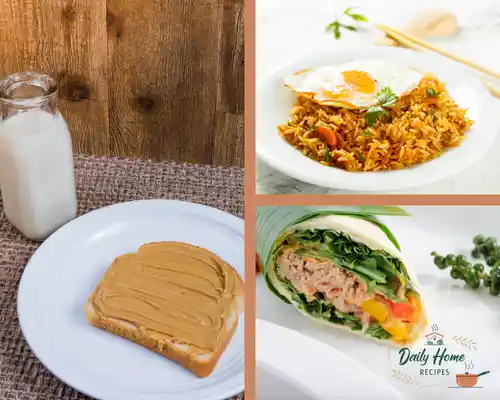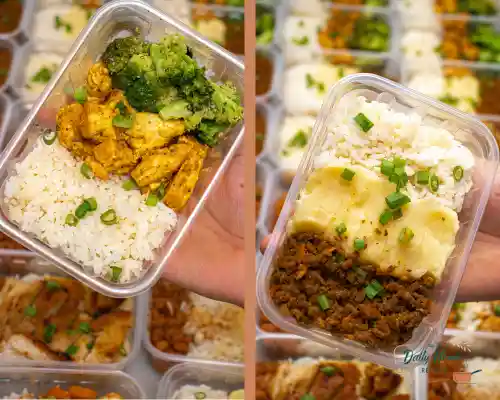Tired of spending $10 just to stay full till 3 p.m.?
You don’t need fancy food or perfect planning. Just a few basics — like eggs, tuna, and lentils — can build real lunches that work.
This guide shows you how to stretch your protein, your meals, and your money without losing your mind by midweek.
Let’s be real—eating something that’s filling, decent, and under budget shouldn’t feel like some mythical life skill. And yet, here we are. Protein costs more than your rent per ounce, takeout guilt hits faster than the hunger pangs, and even when you think you’ve eaten enough… you’re back in the fridge by 2 p.m.
Honestly? It’s exhausting.
This isn’t a cute Pinterest list with quinoa stacks and avocado roses. This is survival food for when your wallet’s on edge, your fridge is half-faith and leftovers, and you just need something real.
Inside, we’re skipping the fluff and going straight to what matters:
- Which ingredients stretch your dollars and your appetite
- Five scrappy meals you can slap together without measuring or second-guessing
- A meal prep plan that feeds you for a week—for less than what some people spend on coffee
- Hacks to keep it all going without spiraling into food boredom or budget regret
Because when money’s tight, food shouldn’t feel like another thing you’re failing at. It should just… work..
Core Ingredients That Stretch Your Budget (Cost Breakdown)
Stretching your food money isn’t about clipping coupons or chasing deals every week. It’s about finding ingredients that do more than they cost. The kind you lean on when your fridge is empty-ish but you still need something real on the plate.
- Eggs (~$2/dozen): They’re the fix-all. Whether you’re frying two for toast or boiling half a dozen for grab-and-go snacks, eggs never stop being useful. They’re fast, versatile, and don’t ask much.
- Tuna (~$1/can): Straight from the can into a meal. Throw it in a wrap, mix with whatever condiment you’ve got, and it’s lunch. No heat required, no excuses.
- Lentils (~$1.50/lb): They don’t look like much in the bag, but a single batch turns into multiple solid meals. You get protein, fiber, and that full feeling that keeps you going past 3 p.m.
- Rice (~$1/bag): Always there when you need it. Maybe bland alone, but pair it with anything—eggs, veggies, chicken—and suddenly it makes sense.
- Frozen Veg (~$1.25): A backup that becomes a regular. No chopping, no spoilage. You steam it, stir it in, done. Nothing wasted.
- Greek Yogurt (~$3.50): Think beyond breakfast. You can mix it with peanut butter, fruit, or use it as a dip for savory stuff. Thick, high-protein, and surprisingly filling.
- Chicken Thighs (~$4/pack): When you want something hearty that won’t dry out or kill your grocery bill. Roast a few, cut them up, make them last.
- Wraps or Bread (~$2.50): They’re the middleman between “random ingredients” and “actual food.” Whatever’s cheap and holds together works.
Dollar-for-Dollar, What Fills You Best?
If you’re chasing max protein per penny, stick with eggs, tuna, and lentils. They’re the gritty trio that shows up when the budget’s tight and the hunger’s loud..
5 High-Protein Lunches Under $5 (No Measuring Required)

Some days, the goal isn’t to cook—it’s just to eat. These meals are more like combinations than recipes. You don’t need teaspoons or timers, just a few low-cost basics and a little instinct.
| Meal Name | Main Ingredients | Estimated Cost | Protein (Approx.) | Time Required |
|---|---|---|---|---|
| “Whatever Tuna Wrap” | Canned tuna + frozen veg + wrap | $2 | ~20g | 5 minutes |
| Lentils, Rice & Scrambled Egg | Cooked lentils + rice + egg | $1.25 | ~15–18g | 10 minutes |
| Egg Toast Stack | Eggs + bread + leftover veggies | $1 | ~12g+ | 5 minutes |
| Yogurt Bowl Remix | Greek yogurt + peanut butter | $1.25 | ~18–20g | 2 minutes |
| Chicken + Rice Dump Bowl | Chicken thigh + rice + frozen veg | $2.50 | ~25g | 10 minutes |
1. The “Whatever Tuna Wrap”
- What to do: Open a tuna can. Heat up frozen veg. Mix, slap into a wrap, hit it with mustard or hot sauce. No rules.
- Ballpark Cost: $2
- Protein: ~20g
- Why it hits: Takes five minutes, fills the tank, and doesn’t leave you sad.
2. Lentils, Rice & a Scrambled Egg
- What to do: Warm some rice and lentils (batch-cooked, ideally). Scramble an egg and mix. If you’ve got garlic powder, now’s the time.
- Ballpark Cost: ~$1.25
- Protein: Depends, but decent
- Why it hits: Solid texture, hot meal, makes leftovers feel intentional.
3. Egg Toast Stack (or Pile)
- What to do: Two eggs, two pieces of bread. Toast, cook, combine. Add in whatever veggie scraps you’re about to forget in the drawer.
- Ballpark Cost: ~$1
- Protein: ~12g+
- Why it hits: One pan, one toaster, five minutes, done. No overthinking required.
4. Yogurt Bowl Remix
- What to do: Scoop out Greek yogurt, add peanut butter. If there’s fruit in the house, slice it in. Stir it all together until it stops looking sad.
- Ballpark Cost: ~$1.25
- Protein: ~18–20g
- Why it hits: No cooking, no mess, and it low-key feels like dessert.
5. Chicken + Rice Dump Situation
- What to do: Leftover chicken thigh, some rice, frozen veg. Heat it all up in one container. Add spice, lemon, soy sauce—whatever brings it to life.
- Ballpark Cost: ~$2.50
- Protein: ~25g
- Why it hits: Fast, hot, filling. Doesn’t pretend to be fancy—and that’s the point.
But Is This “Meal” Enough?
Yup. It’s not about culinary excellence—it’s about getting fed without spending your last ten bucks. These meals show up when your energy (and budget) don’t.
How to Meal Prep a Week of High-Protein Lunches for $25
Okay, so this won’t land you on a meal-prep Instagram page. But it will get you through the week with food that doesn’t suck—and doesn’t leave you stressing at checkout. $25, a little bit of planning, and some repetition. That’s all it takes.
Step 1: What You’re Buying
Here’s what you grab—not fancy, just functional:
- A dozen eggs – around $2
- Two cans of tuna – about $2
- One pound of dry lentils – $1.50-ish
- A bag of rice – roughly $1
- Frozen veggie mix – $1.25
- Pack of chicken thighs – about $4
- Plain Greek yogurt (big tub) – ~$3.50
- Bread or wraps – $2.50 range
- Peanut butter – about $2.50
- A few bananas – around $1.50
You’re walking out just under $25, maybe even a dollar or two under if you shop smart. Enough left over for some hot sauce or one good spice, if you want to feel fancy.
Step 2: What You’re Eating All Week
This isn’t about variety—it’s about not starving by Wednesday. Here’s the rough plan:
- Lentils + Rice + Veggies (3 meals):
Cook one batch, use it three times. Add an egg if it feels too plain. - Tuna Wraps (2 meals):
Mix with mustard, roll into a wrap, maybe toss in a handful of frozen veg. Done in under five. - Chicken + Rice Bowls (2 meals):
Roast the thighs all at once. Slice, portion, reheat. Add frozen veggies and maybe some soy sauce. - Bonus: Yogurt + Peanut Butter Bowl (for when you forget to prep):
No stove, no energy needed. Scoop, stir, eat. Banana on the side if it’s not mushy yet.
Step 3: Keep It Simple
You don’t need a spreadsheet or ten containers. You just need a plan that doesn’t fall apart by Thursday.
- Pack lunch the night before. Morning-you is unreliable.
- It’s okay to eat the same thing twice in a row.
- Freeze anything you’re not eating within two days.
- Eat the stuff you’re least excited about first. Trust me.
Won’t I Get Sick of This?
A little, yeah. But that’s survival mode. You’re buying consistency, not excitement. When the budget loosens up, you can get weird with your meals again. For now? You’re just making it through the week without hitting the drive-thru.
Eating cheap doesn’t start at the checkout. It starts with what you don’t buy, what you already have, and how you avoid letting stuff rot in the fridge. These aren’t magic tricks—just a handful of habits that make the rest easier.
Use What You’ve Got First
Before you make a grocery list, open your fridge. That half onion? The leftover rice? Use those first. Most food waste comes from forgetting what you already paid for.
Batch What You Can
If you’re boiling rice or cooking lentils, don’t make just enough for one meal. Cook the whole bag. It takes the same amount of time, and now you’ve got meals half-built for the week.
Stick to a Few Core Proteins
You don’t need five different meats in the fridge. Pick two—say, eggs and lentils—and build everything around those. Fewer ingredients = less waste, less stress.
Freeze Before You Forget
Don’t leave “leftovers” sitting in the fridge until they’re a science project. Freeze them immediately if you know you won’t eat them tomorrow. Future-you will be grateful—and less broke.
Flavor Is Cheap—Use It
Keep one or two good condiments on hand. Hot sauce, soy sauce, mustard—whatever works for you. A splash of something with a kick can rescue even the most repetitive meal.
What’s the #1 Habit That Saves the Most?
Honestly? Planning just three days ahead. Not the whole week, not some Pinterest chart—just a rough idea of what you’ll eat until Thursday. That alone cuts the “screw it, I’ll just grab something” moments by half.
Where to Splurge vs Save (Budget Food Wisdom)
You don’t have to treat every grocery trip like a survival game. Some things are worth spending a little more on—because they make you actually eat what you bought. The trick is knowing where to hold back… and where loosening up actually saves you in the long run.
Where to Cut Back Without Regret
- Dry Staples:
Rice, oats, lentils, beans—go with the cheapest store brand. The difference in taste? Minimal. The difference in price over time? Big. - Frozen Veggies:
No need to buy fresh if you’re not going to use it in two days. Frozen is cheaper, just as nutritious, and won’t rot in the crisper drawer while you “figure it out.” - Canned Tuna & Sardines:
Most no-name brands are basically identical to the fancy stuff. Just check the label for protein content and sodium, and you’re set.
When It’s Worth Spending a Little More
- Protein Quality:
If eggs are a staple, buy better ones when you can. Same with chicken—spending an extra buck or two might mean better taste and less waste (because you’ll actually eat it). - Greek Yogurt:
Some store-brand tubs are so watery you won’t touch them after day one. A slightly thicker, better one might cost $1 more, but you’ll finish it. - Condiments & Basics:
A good $3 hot sauce or decent mustard can completely change your lunch game. If it makes five boring meals tolerable, it’s money well spent.

So… When Should You Spend More?
When it helps you follow through. If spending $1 extra means you won’t throw half of it out, or you’ll actually eat the thing instead of skipping lunch, that’s not a splurge—it’s smart budgeting.
Here’s the truth: most people don’t stick to a perfect plan. They improvise, get tired, forget what they bought, maybe eat the same thing three days straight. That doesn’t mean they’re doing it wrong—it just means they’re doing what they can.
The meals here aren’t trying to impress anyone. They’re just meals that work when you’re low on time, low on energy, and trying not to burn through your last $20 before Friday. And that’s more than good enough.
So if some part of this helps you eat one decent lunch this week, that’s already a win. The rest? You’ll figure it out as you go.

Leave a Reply